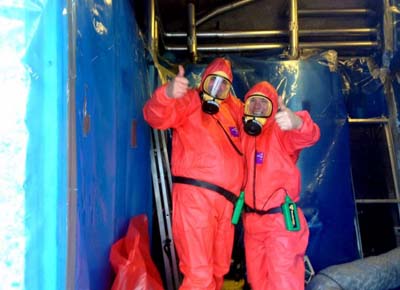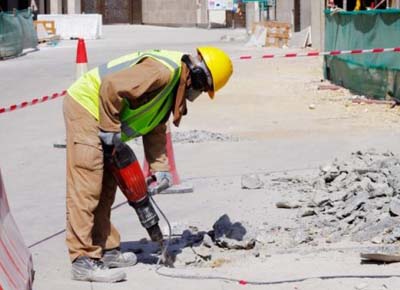Periodic and Statutory medicals
Periodic medicals
- Fork-lift truck drivers medicals
- HGV and PCV medicals
- Climbers assessments
- Shift workers medicals
- Food handlers medicals
Statutory medicals
- Asbestos appointed doctor medicals
- Tiered Hand Arm Vibration Syndrome medicals
Hand Arm Vibration Syndrome (HAVS) is often referred to as vibration white finger; it can affect anybody who regularly uses hand held vibrating tools. With more than 2,000,000 workers in the UK at risk of HAVS, it is imperative that employers have an adequate process to detect early symptoms, and implement adequate controls to prevent the condition worsening. Regular health surveillance is part of this process.
The cost of HAVS to businesses can be high. Workers can suffer physically and lose productivity. It can be costly to employers with claims currently averaging around £60,000. Injuring workers, and the subsequent negative publicity regarding court proceedings, can be severely damaging to the reputation of businesses.
As part of our health surveillance service, we can offer a convenient and flexible workplace HAVS screening service, with all assessments undertaken by suitably qualified and competent occupational health staff.
The Control of Vibration at Work Regulations 2005 was introduced to protect workers from risks to health due to the overuse of handheld power tools (eg grinders, hammer drills, polishers, sanders, breakers, etc.), hand-guided machinery (such as lawnmowers and plate compactors) and hand-fed machinery (such as pedestal grinders). The majority of the regulations are centred on how employers should protect their employees, but part of the regulation calls for suitable health surveillance from qualified professionals.
The Control of Vibration at Work Regulations introduces a detailed “Tier System” for HAVS assessments.
The assessment process is divided into five stages depending on the severity of damage caused by vibration. The first two tiers of the HAVS screening process can be carried out by a responsible person, a manager with suitable training, or or a qualified person, one of our Occupational Health Advisors (OHNA). The Health and Safety Executive (HSE) recommends that tier 3 assessments are only undertaken by a qualified person, either an OHNA or our specialist Occupational Health Physician (OHP)
Tier 1 – Initial or baseline assessment There should be an initial HAVS assessment for any new or existing employee before they begin any exposure to hand arm vibration. This will provide an opportunity to educate workers about measures under their control, with a view to reducing potential risks from the transmission of hand arm vibration. This assessment is generally a self-administered questionnaire.
Tier 2 – Annual Screening Questionnaire The self-administered HAVS questionnaire should be repeated annually to form the routine health surveillance for those at risk but without symptoms suggestive of HAVS. If symptoms appear for the first time, or progress, workers should be encouraged to report them rather than wait for the next round of screening. The HSE recommends that after three years of reporting no symptoms the worker should be referred for a consultation with the qualified professional to fully explore any possible symptoms that may have been disregarded.
Tier 3 – Assessment by qualified person This should normally follow Tier 2 if symptoms are reported. The assessment should be conducted by the qualified person. The doctor may be involved in carrying out some or all of the assessment in Tier 3, according to the contractual arrangements made with your occupational health provider.
Tier 4 – Formal diagnosis Formal diagnosis of hand arm vibration (HAVS) can only be made by a competent doctor. With the employee’s consent we will inform the employer in order that appropriate remedial action can be taken to either reduce or stop further vibration exposure and to review it’s risk assessment and improve controls. It is also necessary to enable the employer to report confirmed cases of HAVS to the HSE under the Reporting of Injuries Diseases and Dangerous Occurrence Regulations 2013 (RIDDOR).
Tier 5 – Use of standardised tests (optional) In addition to clinical findings from Tiers 3 & 4, standardised tests can be conducted for a worker who has signs or symptoms of HAVS. This tier is NOT required as part of routine health surveillance provision for a workforce exposed HAVS, although it is useful for studying the progression of the disease.
Occupational health professionals undertaking clinical assessments under the Control of Vibration at Work Regulations 2005 must demonstrate their competence. All should have specialist training and should hold a recognised Occupational Health qualification in nursing and/or medicine. They should also have undertaken the Faculty of Occupational Medicine’s approved training for health professionals for HAVS.
Note: the term ‘qualified’ refers to those health professionals that have attended and passed a HSE approved HAVS medical assessment training course.
Dr Zubier has recently updated his training, having passed the Faculty of Occupational Medicine (FOM) HAVS assessment of competence in 2012 and 2016. This is the only guarantee of competence.
We provide basic health surveillance and advice. We can perform Tier 1 and Tier 2 assessments, giving advice on surveillance frequency and interpreting questionnaires. These can be performed by our on-site Occupational health nurse and/or physicians.
We carry out higher levels of health surveillance Tier 3/ Tier 4 at our facilitated Occupational Health site or on site.
We provide reports following assessment with advice and guidance.
Employers should be aware that only competent doctors can undertake HAVS assessments.
Can your current OH provider to demonstrate competence? If not, you are putting your employee’s health at risk with obvious medico-legal consequences.

